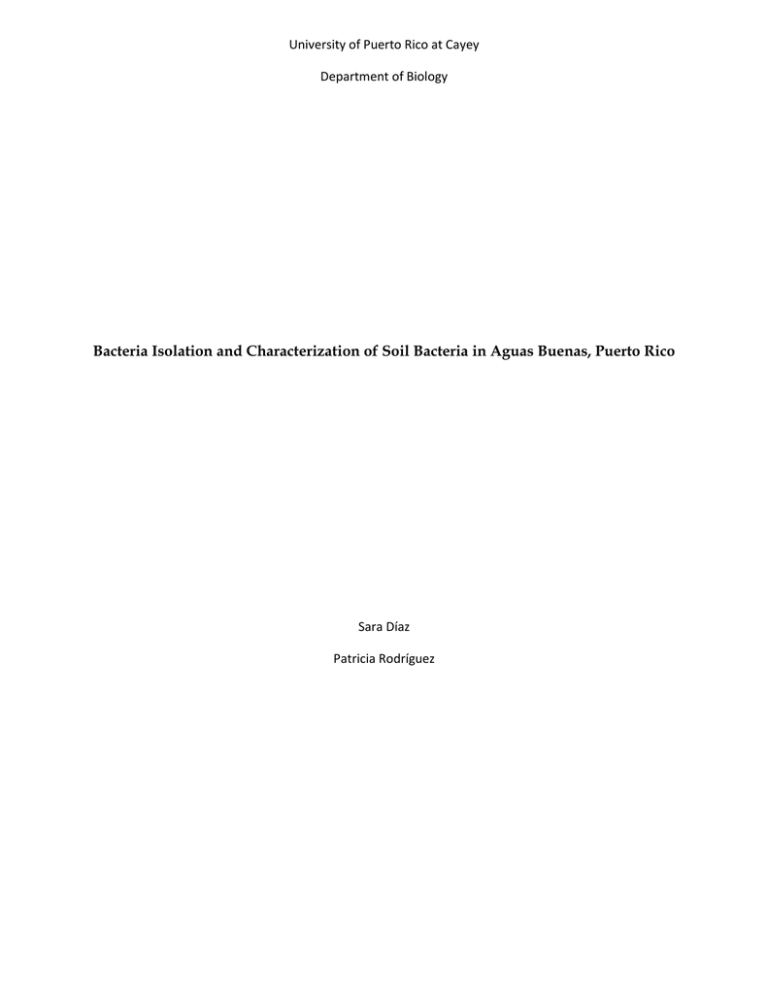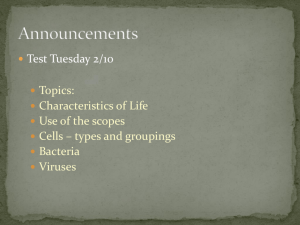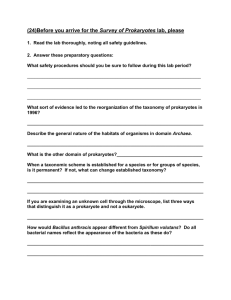Bacteria Isolation and Characterization Research
advertisement

University of Puerto Rico at Cayey Department of Biology Bacteria Isolation and Characterization of Soil Bacteria in Aguas Buenas, Puerto Rico Sara Díaz Patricia Rodríguez Some bacterium are pathogenic while others are harmless. The discovery of new bacterium is important because they are ecologically and medicinally beneficial. A research was carried out to isolate and characterize new soil bacteria with beneficial properties, namely antibiotic production and resistance. A soil sample from Aguas Buenas was collected and the bacterias were isolated, purified, and characterized. In order to prove the hypothesis, a series of tests were carried out. Results demonstrated that the bacteria has some resistance against antibiotic Rifampin. Prokaryotes have been present for approximately directly from soil organisms. This investigation shares three fourths of planet Earth’s history. Throughout this time similar objectives to our research but utilizes a different they have developed the ability to adapt to almost all approach. Studies suggest that the widespread use of ecological habitats. They possess diverse metabolic antimicrobial chemicals may be causing antibiotics to lose capabilities that allow them to use a variety of organic or their effectiveness. Using antimicrobial chemicals frequently inorganic compound as a food source. The concept of enough may have an adverse effect, by destroying some bacteria, tends to be directly related to diseases due to their bacteria and allowing the resistance subset to proliferate. Due pathogenic characteristics. However, these microscopic to the overuse of antibiotics, bacterium have become single celled organisms are essential to our existence because resistant to them. This has led to a major public health crisis. our exposure to them is an important part of the development Certainly, it’s clear that new antibiotics are needed in order of our immune systems. Some bacteria have symbiotic to confront resistance, and their need will be even more relationships with plants and invertebrates where they carry pressing in order to combat emergent diseases in the future. out the processes of nitrogen fixation and cellulose There are a vast amount of bacterial species in the world and degradation in order to sustain these higher life forms. most of them are still unknown. Discovering new bacterium Additionally, bacterium play an indispensable role in the in our environment could have great future benefits. By cycling of chemical elements necessary for human life, soil broadening our knowledge on this field we can determine the fertilization and provision of nutrients. Some bacterium are properties and characteristics of various bacterium and later useful in the preparation of foods, chemicals, and antibiotics. develop innovative ways to counteract their negative effects. Previous studies have been made in order to discover and This is important because many bacterium possess properties characterize new bacterium with the purpose of evaluating beneficial to society’s overall health. Some of these their specific characteristics, for medical and ecological beneficial properties are the ability to degrade oil, produce benefits and applications. As an outside reference for this cellulose activity, and produce or resist antibiotics. The investigation, a research found in NCBI Pub Med done by hypothesis for this research is that we will discover a new MacNeil IA et.al titled Expression and Isolation of soil bacteria with at least two beneficial properties, namely Antimicrobial Small Molecules from Soil DNA Libraries was antibiotic production and oil degradation. The purpose of this used. They carried out a research with the mission of finding research is to discover and catalogue new soil bacteria, while new uncultured bacteria species that would provide an incorporating practical lab techniques. The future undiscovered gene pool. This gene pool could then be used implications of this study are that finding bacteria to degrade to produce natural products for clinical purposes. They were oil will help clean up oil spills all around the world, and also able to support the idea that technology has the potential to produce cellulose activity. Although cellulose is commonly provide new natural products that surge from microbial produced in plants it is also produced by bacteria. In addition diversity and its importance for new tool drug discovery. The one of the main goals is to find bacteria that produce or resist technology they used was a bacteria artificial chromosome bacteria in order to develop new antibiotics. library containing genomic fragments of DNA isolated the original bacterial purifications for each medium type. Methodology Both were observed under the microscope and their cellular Soil was collected from Aguas Buenas in a labeled zip lock bag using a sterile spoon. Tools like a GPS, a camera and a ruler were used to obtain the location’s coordinates, photographs and soil measurements. In the laboratory, the plates for the first enrichment were appropriately labeled. 1.0 g of soil was placed into a beaker and 9ml of distilled water were added, creating the 100 solution. The 10−2 𝑡𝑜 10−5 serial dilutions were made from the 100 soil suspension and deposited in six labeled test tubes. 50µl from the 10^0 solution were placed on the center of the respective medium plate. An L shaped streaking loop was used to streak using the appropriate techniques. The previous step was repeated using the 10−5 solution. The plates were left for incubation at 30⁰C for 48-72 hours. Afterwards, an RDM and a TSA plate were used to incubate the bacterial colonies. The swab streak technique was carried out using an inoculating loop and the plates were incubated at 300C. In order to be able to prepare samples for cryogenic freezing, a liquid culture of each isolate was prepared by transferring 3mL of broth into the appropriate media. The purified bacterium were incubated at 300C and left overnight. The next day, two cryogenic tubes were labeled for each isolate, a working stock and a permanent stock. 1ml of 80% glycerol was added to the liquid cultures. The tubes were left overnight in the freezer at -800C. After 24 hours, the cultures were taken out of the freezer. A viability test of the cell stocks was performed by streaking the cultures using an inoculating loop. Lastly they were incubated at 300C. The genomic DNA purification was performed by transferring 500µl of the morphology was documented. A drop of water was placed on a microscope slide. A small amount of a single colony was picked up with a sterile loop and the cells were suspended by rubbing the loop in the water drop. The suspension was spread out, air dried, and heat fixed in the iron. The heat fixed smear was flooded with crystal violet for 1 minute and then rinsed gently in flowing tap water. Remaining water was washed off with Iodine solution for 1 minute. The smear was covered with a few drops of ethanol and then drained off and rinsed off with tap water. Additional water was washed off with the safranin solution for 1 minute. The excess safranin was washed off and the slide was blotted between sheets of paper towel to dry. The smear was placed under the microscope and examined with oil immersed lens. Depending on the visible color, the gram type of the bacteria was identified.The test for antibiotic production was carried out by using an overnight broth for each bacteria respectively. Using the broth, each bacteria was patched onto appropriate plates of M. luteus and E.coli. The plates were incubated at 370C for 48 hours. The next step was inspecting the plates and checking for any evidence of clearing. The test for antibiotic resistance was carried out by dipping a sterile cotton swab into the bacterial culture tube and swabbing it on the entire surface of the agar plate. The plate was left to dry for 15 minutes. The selected antibiotic discs were placed on the culture-painted plate which were incubated for 48 hours. Data analysis took place to check for inhibition growth zones. Aseptic techniques were used throughout all the previous procedures. liquid culture broth into a micro centrifuge tube. The tubes were placed in each station: 1000C water, ice, and the micro centrifuge at 14K RPM for 10 minutes. Finally, 300µl from the supernatant were transferred into clean tubes and kept in ice. To set up the PCR 6µl of DNA were added to the PCR tube. The gel electrophoresis was prepared by having 1 molecular gel marker of 1.5K base band. The PCR products were purified. The gel electrophoresis amplification was performed by placing the PCR samples into the gel. The colonies were examined and characterized by using one of Results and Discussion A total of two bacteria were isolated successfully and characterized. The soil samples were collected from Aguas Buenas, Puerto Rico. The temperature was moderate at 270C. The bacterial names are: S15UPRC-RISEPRM30M01A and S15UPRC-RISESCDM30T01B. The first sample was collected from "La Charca" in Aguas Buenas. The shape of the bacteria was circular with a curled margin and a raised/flat elevation. The texture was smooth and its appearance was gram stain was gram positive and the bacteria’s cells were glistening. Its optical property was opaque. The result of the identified as bacillus. Observation 2.2 shows a photograph of gram stain was gram positive and the bacteria was identified the gram stain slide. Observation 2.3 shows a photograph of as bacillus. The results of the antibiotic resistance were all the antibiotic resistance plate against the antibiotics negative. The test for antibiotic production showed that the Vancomycin, Rifampin, Tetracyclin, Streptomycin, and bacteria did not produce antibiotics against E. coli or M. Kanamycin. Observation 2.4 shows a graph of each antibiotic luteus. It showed that they could coexist because it did not and their respective diameter of bacterial clearing. It inhibit bacterial growth. The second isolation was also demonstrates that the bacteria was most effective in resisting collected from "La Charca" in Aguas Buenas. The shape of the Rifampin and less efective in resisting Streptomycin. The bacterial colony was rhizoid with a undulated margin and a bacteria was not able to inhibit M. luteus or E. Coli growth, flat elevation. The texture was smooth and its appearance was giving negative results in the antibiotic production tests. dull. Its optical property was transparent. Observation 2.1 Future experiments include the performance of oil and shows a photograph of its bacterial colony. The result of the cellulose assays. References: 1) Macneil, I.A, CL Tiong, C. Minor, PR August, TH Grossman, and KA Loaicono. "Expression and Isolation of Antimicrobial Small Molecules from Soil DNA Libraries." NCBI PubMed. 3 Apr. 2001. Web. Annex: Observation 2.1 Observation 2.4 3.33 6.25 7.14 5.88 7.69 ANTIBIOTIC RESISTANCE DIAMETER OF CLEARING (CM^-1) Observation 2.2 Observation 2.3 V A N C O M Y C I N R I F A M P I N T E T R A C Y C L SI NT R E P T O M Y C I KNA N A M Y C I N ANTIBIOTIC







